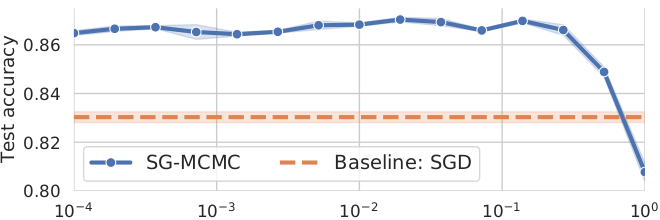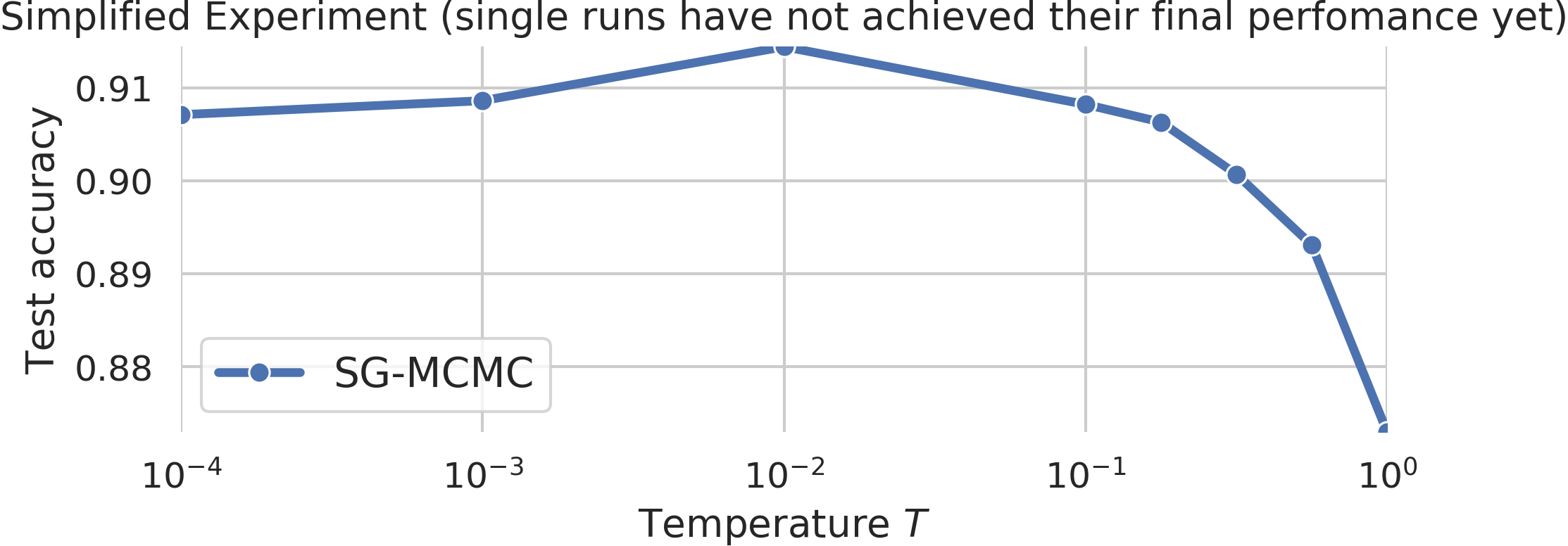This repository contains code to run the SG-MCMC experiments from the paper How Good is the Bayes Posterior in Deep Neural Networks Really? to reproduce its figures 1, 2, and 3.
Abstract: During the past five years the Bayesian deep learning community has developed increasingly accurate and efficient approximate inference procedures that allow for Bayesian inference in deep neural networks. However, despite this algorithmic progress and the promise of improved uncertainty quantification and sample efficiency there are---as of early 2020---no publicized deployments of Bayesian neural networks in industrial practice. In this work we cast doubt on the current understanding of Bayes posteriors in popular deep neural networks: we demonstrate through careful MCMC sampling that the posterior predictive induced by the Bayes posterior yields systematically worse predictions compared to simpler methods including point estimates obtained from SGD. Furthermore, we demonstrate that predictive performance is improved significantly through the use of a "cold posterior" that overcounts evidence. Such cold posteriors sharply deviate from the Bayesian paradigm but are commonly used as heuristic in Bayesian deep learning papers. We put forward several hypotheses that could explain cold posteriors and evaluate the hypotheses through experiments. Our work questions the goal of accurate posterior approximations in Bayesian deep learning: If the true Bayes posterior is poor, what is the use of more accurate approximations? Instead, we argue that it is timely to focus on understanding the origin of the improved performance of cold posteriors.
This repository contains code to reproduce the experiments from the paper that demonstrate cold posterior effect for a ResNet-20 model on the dataset CIFAR-10 and a CNN-LSTM model on IMDB sentiment dataset. We can improve the generalization performance significantly by cooling the posterior with a temperature T<<1. The cold posterior sharply deviates from the true Bayes posterior (which is attained for T=1).
| ResNet-20 / CIFAR-10 | CNN-LSTM / IMDB |
|---|---|
 |
 |
 |
 |
All bash files have to be executed from the parent folder of cold_posterior_bnn/ (see below).
To install the required packages in a python virtual environment and run tests, run
cold_posterior_bnn/run.shResNet-20 experiment
To reproduce the ResNet-20 experiment from the paper, run the following command. Attention, this can take up to 30 days on a single GPU!
cold_posterior_bnn/run_resnet_experiment.shFor a simplified version of the experiment that only takes 1-2 days on a single GPU, run the following command. For the simplified experiment we halved the number of epochs and included less temperature evaluations. Due to the lower number of total epochs the individual runs are not all converged and the final performance is worse than in the full experiment. However, this experiment still shows the cold posterior effect.
cold_posterior_bnn/run_resnet_experiment_small.shTo aggregate the results of the different runs and to produce the final plot, open the notebook
cold_posterior_bnn/plot_results.ipynb
The results of the simplified ResNet experiment are stored in the folder cold_posterior_bnn/results_resnet.
CNN-LSTM experiment
To reproduce the CNN-LSTM experiment from the paper, run the following command. Attention, this can take up to 15 days on a single GPU!
cold_posterior_bnn/run_cnnlstm_experiment.shFor a simplified version of the experiment that only takes around one day on a single GPU, run
cold_posterior_bnn/run_cnnlstm_experiment_small.shTo aggregate the results of the different runs and to produce the final plot, open the notebook
cold_posterior_bnn/plot_results.ipynb
The results are stored in the folder cold_posterior_bnn/results_cnnlstm.
Florian Wenzel ([email protected])
Rodolphe Jenatton ([email protected])
Sebastian Nowozin ([email protected])
Florian Wenzel, Kevin Roth, Bastiaan S. Veeling, Jakub Swiatkowski, Linh Tran, Stephan Mandt, Jasper Snoek, Tim Salimans, Rodolphe Jenatton and Sebastian Nowozin (2020). How Good is the Bayes Posterior in Deep Neural Networks Really?. In arXiv preprint arXiv:2002.02405.
@article{wenzel2020good,
author = {Florian Wenzel and Kevin Roth and Bastiaan S. Veeling and Jakub Swiatkowski and Linh Tran and Stephan Mandt and Jasper Snoek and Tim Salimans and Rodolphe Jenatton and Sebastian Nowozin},
title = {How Good is the Bayes Posterior in Deep Neural Networks Really?},
journal={arXiv preprint arXiv:2002.02405},
year = {2020},
}
